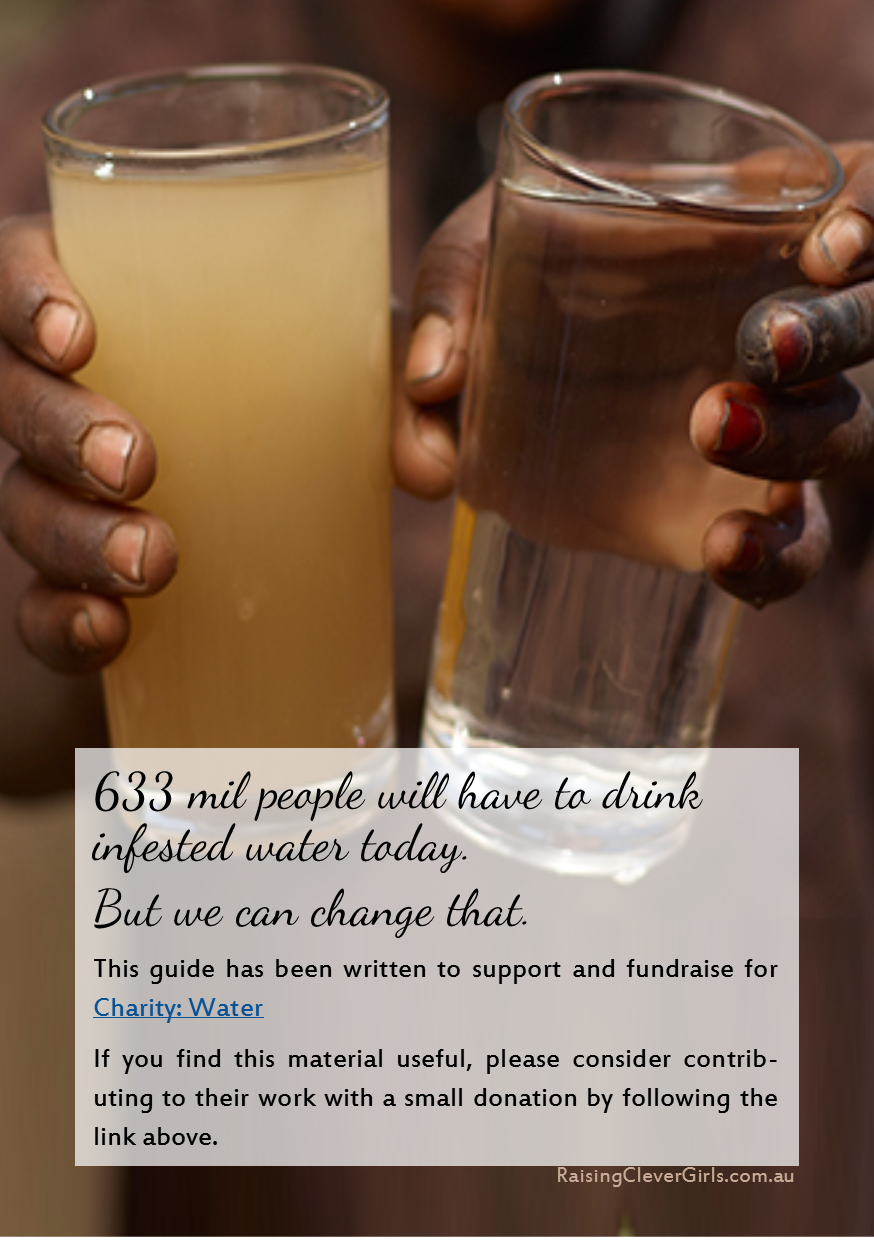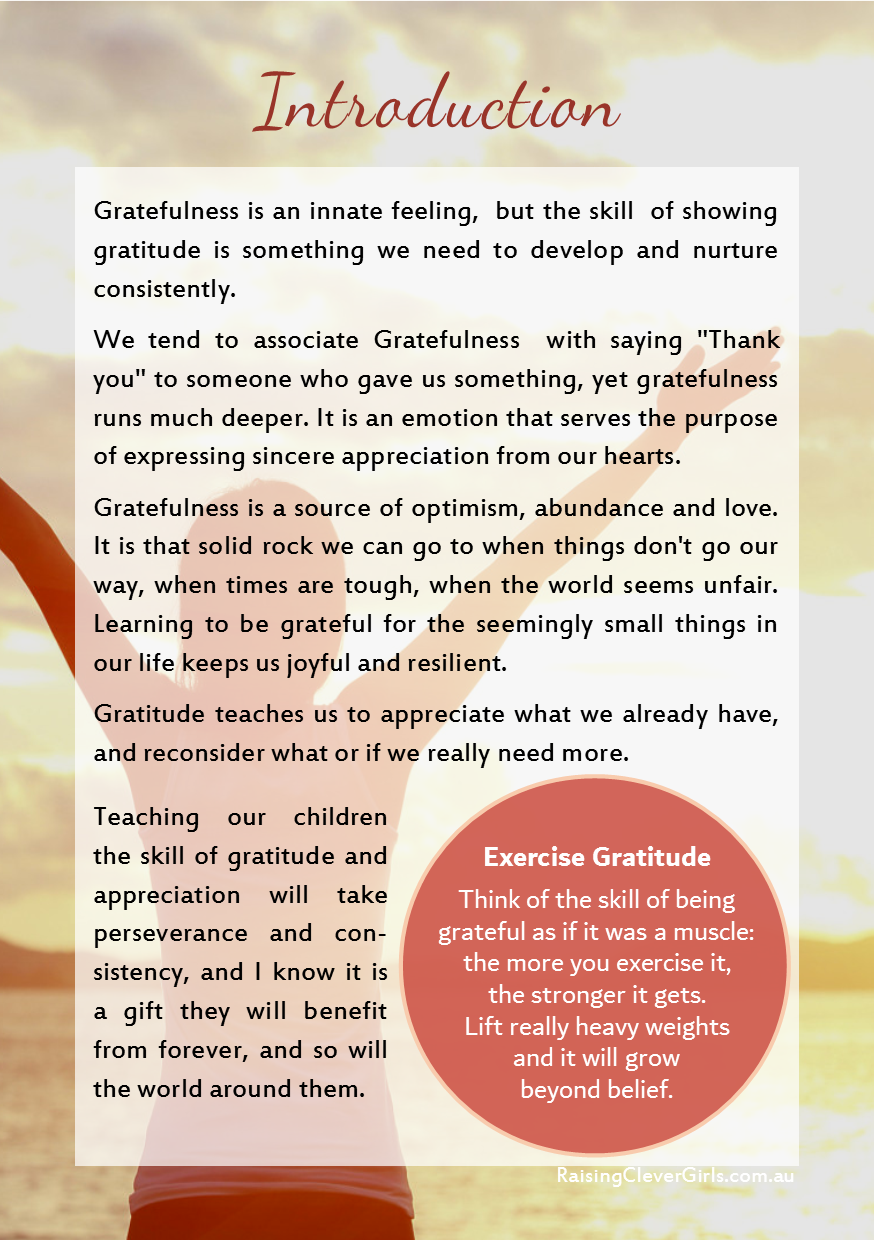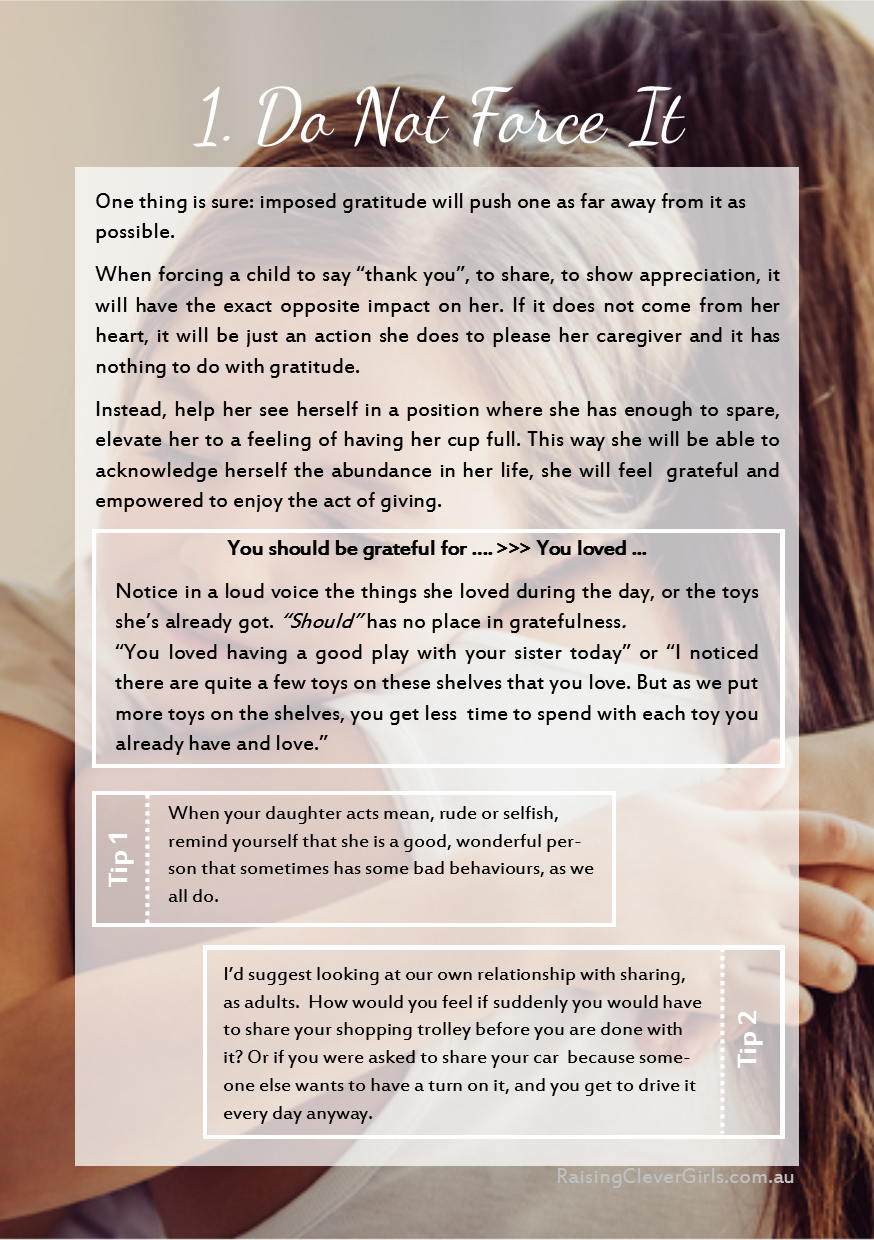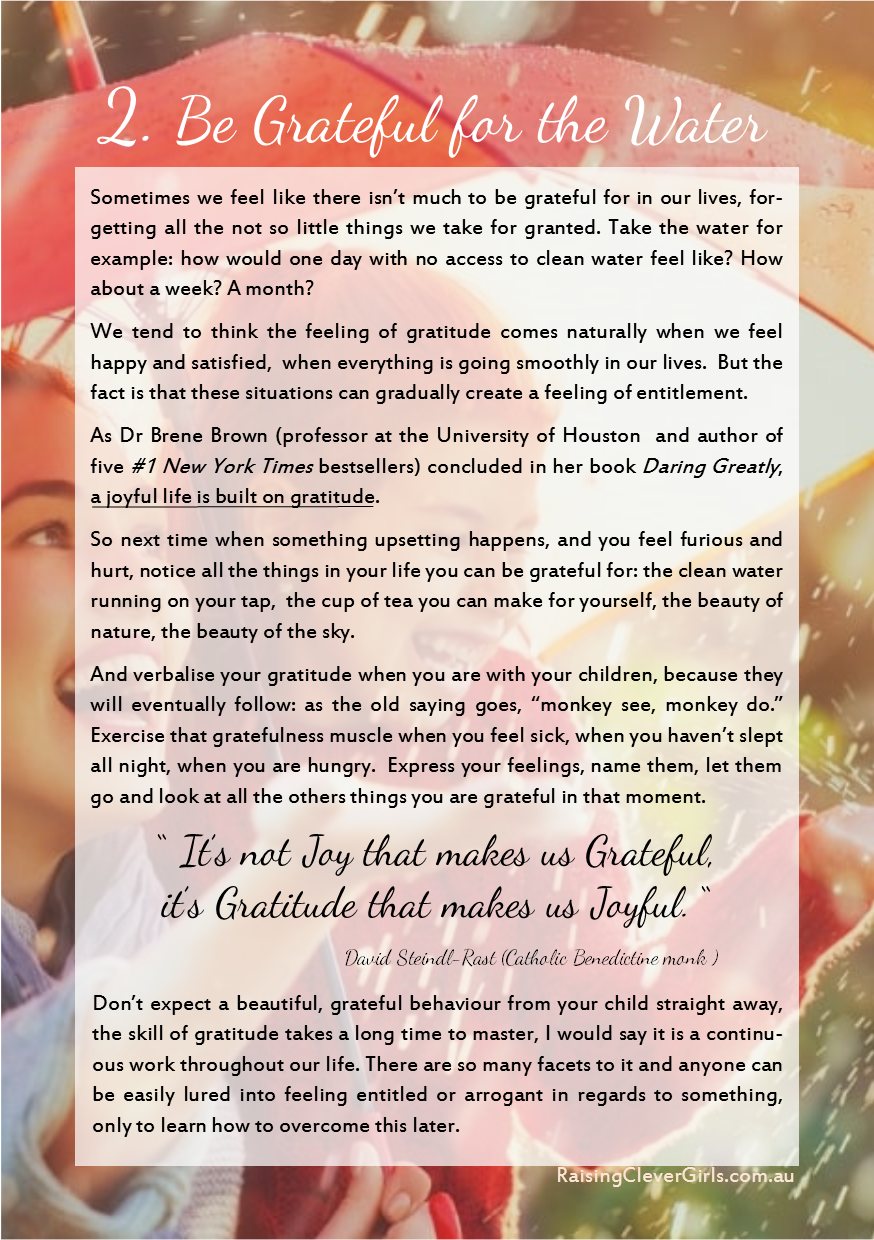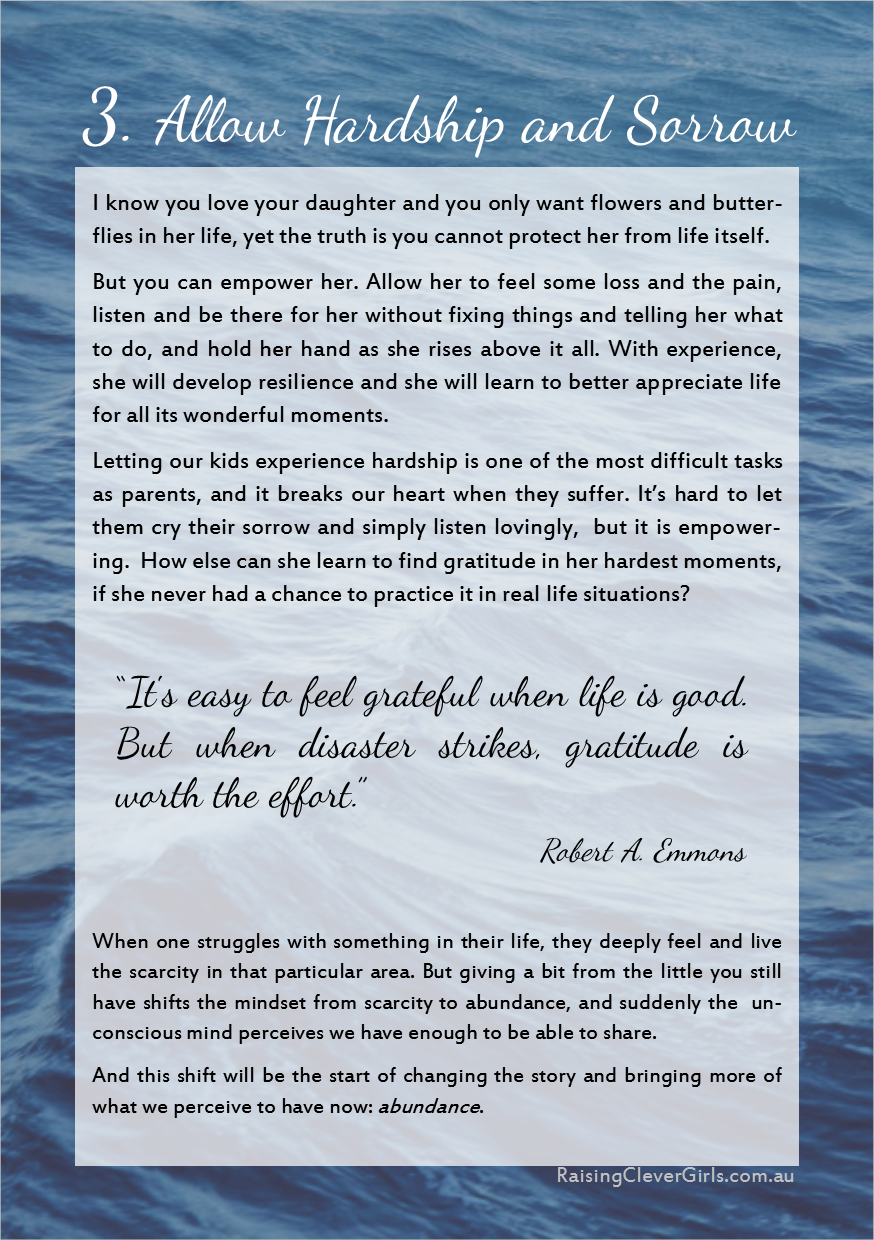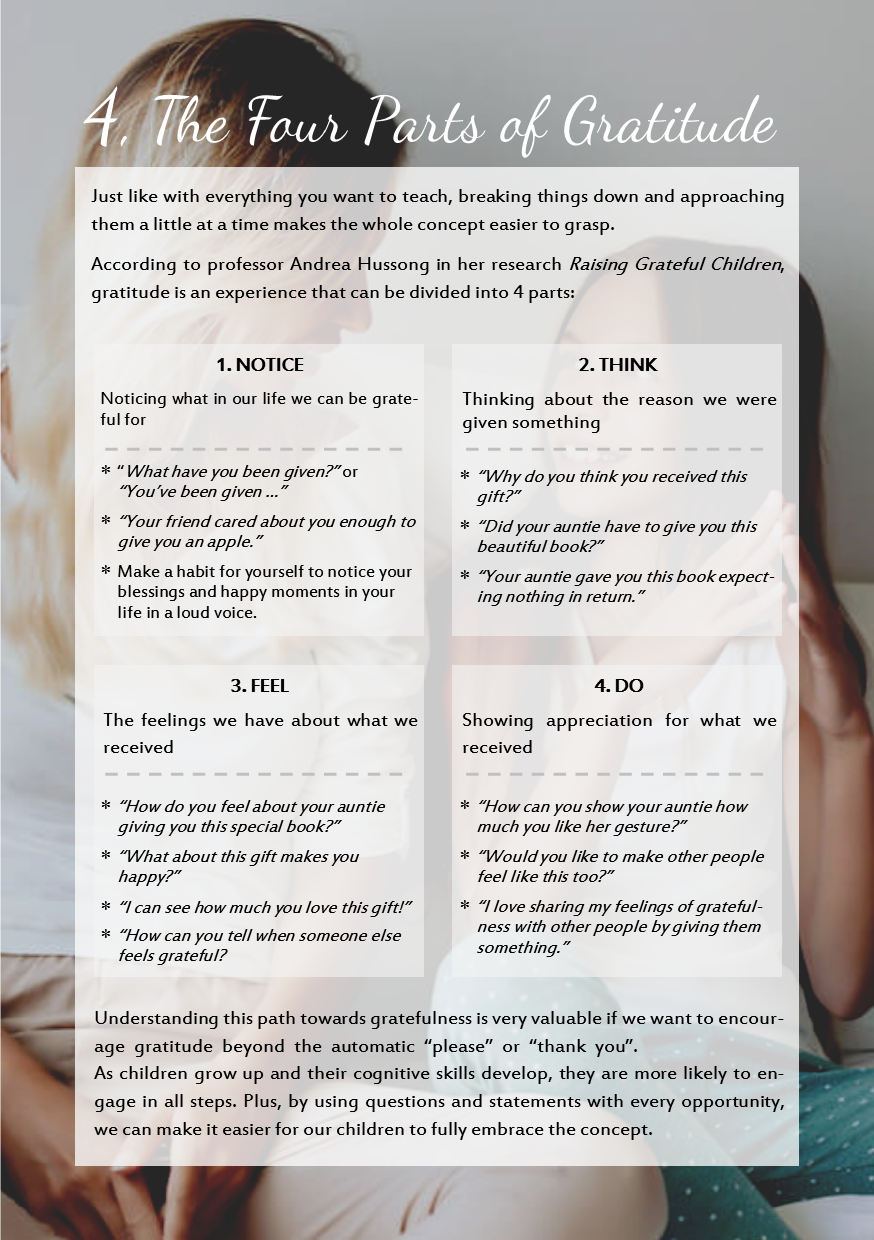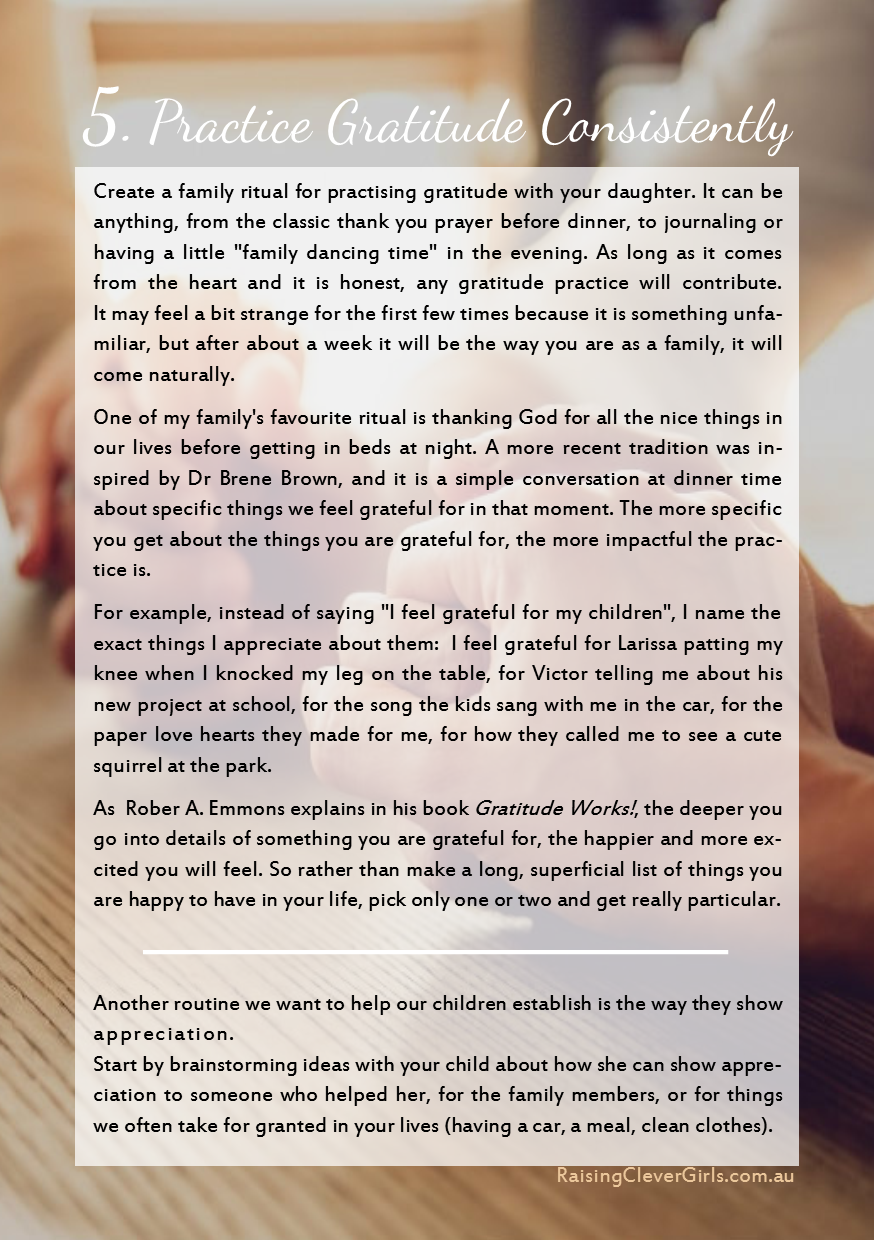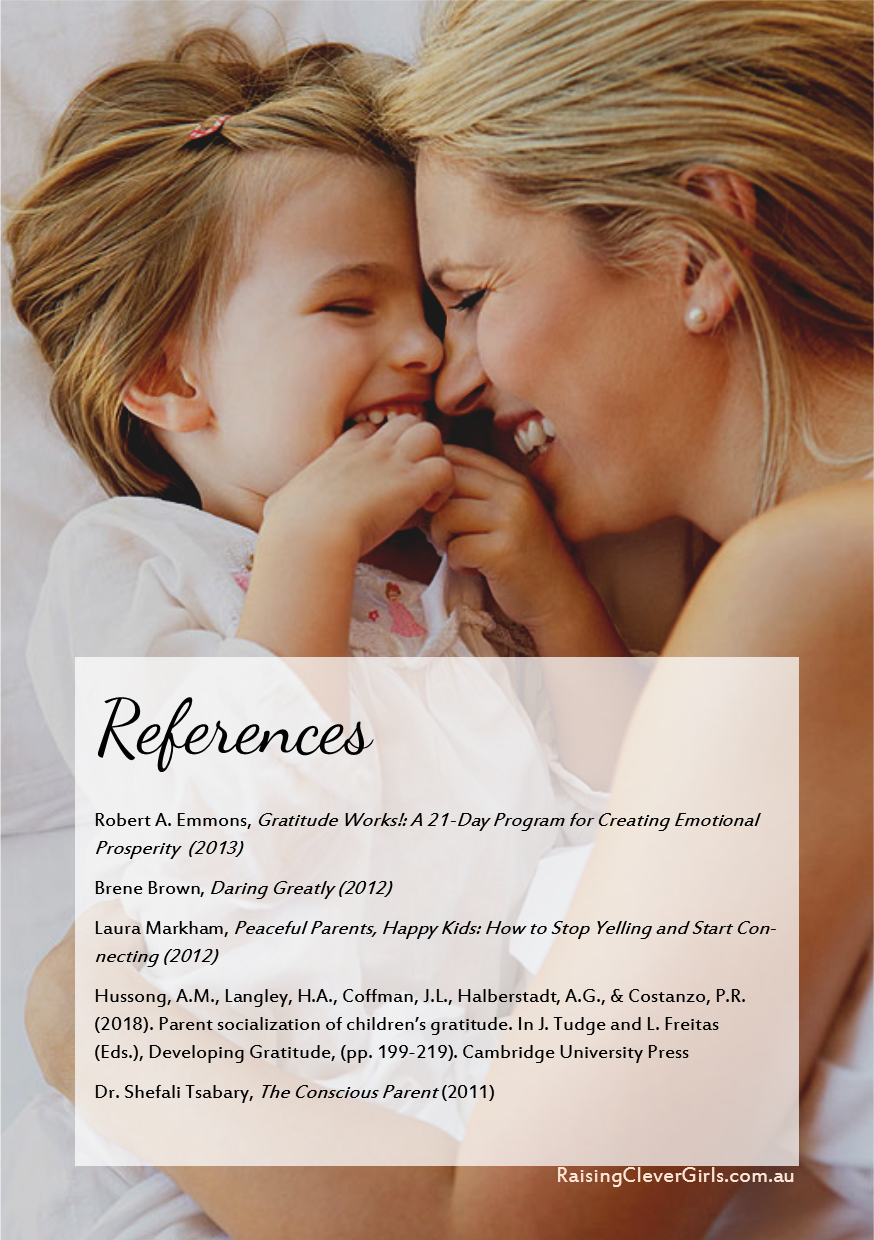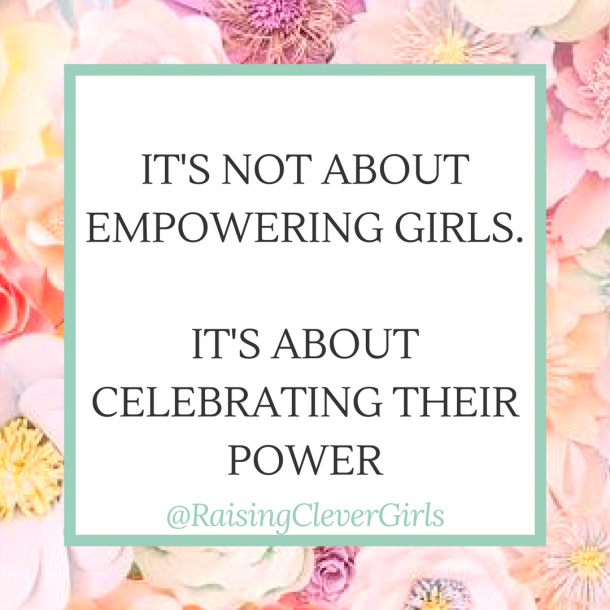
The concept of rich and poor imply comparing people, and this never ends well. If we would have to compare, let’s keep in mind that 633 million people on Earth will have to drink dirty, infested water today because they have no other option.
Speaking for myself, I know there always will be people that will have more stuff than my children ever will, and I also know that this has nothing to do with feeling gratitude.
I look around and I can see all sort of ads showing us yet another piece of clothing/ diet/ car/ holiday that will make us feel like we are not really happy yet, and that thing will make it all better. But the truth is that things don’t make it all better. It is only a matter of time until the newness will wear off and we will stop fully appreciating the object of our desires.
Raising grateful children in a materialistic world takes acceptance and guidance, along with mindfulness and perseverance.
In the guide below I highlighted the 5 most important actions I think parents can take to highlight and nurture the feeling of appreciation and gratefulness in children for a happier family life.
Transcript
5 Steps from Spoiled to Grateful
633 mil people will have to drink infested water today.
But we can change that.
This guide has been written to support and fundraise for
Charity: Water
If you find this material useful, please consider contributing to their work with a small donation by following the link above.
Introduction
Gratefulness is an innate feeling, but the skill of showing gratitude is something we need to develop and nurture consistently.
We tend to associate Gratefulness with saying “Thank you” to someone who gave us something, yet gratefulness runs much deeper. It is an emotion that serves the purpose of expressing sincere appreciation from our hearts. Gratefulness is a source of optimism, abundance and love. It is that solid rock we can go to when things don’t go our way, when times are tough, when the world seems unfair.
Learning to be grateful for the seemingly small things in our life keeps us joyful and resilient. Gratitude teaches us to appreciate what we already have, and reconsider what or if we really need more.
Teaching our children the skill of gratitude and appreciation will take perseverance and consistency, and I know it is a gift they will benefit from forever, and so will the world around them.
Exercise Gratitude
Think of the skill of being grateful as if it was a muscle: the more you exercise it, the stronger it gets. Lift really heavy weights and it will grow beyond belief.
1. Do not force it
One thing is sure: imposed gratitude will push one as far away from it as possible. When forcing a child to say “thank you”, to share, to show appreciation, it will have the exact opposite impact on her. If it does not come from her heart, it will be just an action she does to please her caregiver and it has nothing to do with gratitude.
Instead, help her see herself in a position where she has enough to spare, elevate her to a feeling of having her cup full. This way she will be able to acknowledge herself the abundance in her life, she will feel grateful and empowered to enjoy the act of giving.
You should be grateful for …. >>> You loved …
Notice in a loud voice the things she loved during the day, or the toys she’s already got. “Should” has no place in gratefulness. “You loved having a good play with your sister today” or, “I noticed there are quite a few toys on these shelves that you love. But as we put more toys on the shelves, you get less time to spend with each toy you already have and love.”
Tip 1: When your daughter acts mean, rude or selfish, remind yourself that she is a good, wonderful person that sometimes has some bad behaviours, as we all do.
Tip 2: I’d suggest looking at our own relationship with sharing, as adults. How would you feel if suddenly you would have to share your shopping trolley before you are done with it? Or if you were asked to share your car because someone else wants to have a turn on it, and you get to drive it every day anyway.
2. Be grateful for the water
Sometimes we feel like there isn’t much to be grateful for in our lives, forgetting all the not so little things we take for granted. Take the water for example: how would one day with no access to clean water feel like? How about a week? A month?
We tend to think the feeling of gratitude comes naturally when we feel happy and satisfied when everything is going smoothly in our lives. But the fact is that these situations can gradually create a feeling of entitlement.
As Dr Brene Brown (professor at the University of Houston and author of five #1 New York Times bestsellers) concluded in her book Daring Greatly, a joyful life is built on gratitude.
So next time when something upsetting happens, and you feel furious and hurt, notice all the things in your life you can be grateful for: the clean water running on your tap, the cup of tea you can make for yourself, the beauty of nature, the beauty of the sky. And verbalise your gratitude when you are with your children because they will eventually follow: as the old saying goes, “monkey see, monkey do.”
Exercise that gratefulness muscle when you feel sick, when you haven’t slept all night, when you are hungry. Express your feelings, name them, let them go and look at all the others things you are grateful in that moment.
“ It’s not Joy that makes us Grateful, it’s Gratitude that makes us Joyful. “ David Steindl-Rast (Catholic Benedictine monk )
Don’t expect a beautiful, grateful behaviour from your child straight away, the skill of gratitude takes a long time to master, I would say it is a continuous work throughout our life. There are so many facets to it and anyone can be easily lured into feeling entitled or arrogant in regards to something, only to learn how to overcome this later.
3. Allow hardship and sorrow
I know you love your daughter and you only want flowers and butterflies in her life, yet the truth is you cannot protect her from life itself.
But you can empower her. Allow her to feel some loss and the pain, listen and be there for her without fixing things and telling her what to do, and hold her hand as she rises above it all. With experience, she will develop resilience and she will learn to better appreciate life for all its wonderful moments.
Letting our kids experience hardship is one of the most difficult tasks as parents, and it breaks our heart when they suffer. It’s hard to let them cry their sorrow and simply listen lovingly, but it is empowering. How else can she learn to find gratitude in her hardest moments, if she never had a chance to practice it in real life situations?
“It’s easy to feel grateful when life is good. But when disaster strikes, gratitude is worth the effort.” Robert A. Emmons
When one struggles with something in their life, they deeply feel and live the scarcity in that particular area. But giving a bit from the little you still have shifted the mindset from scarcity to abundance, and suddenly the unconscious mind perceives we have enough to be able to share.
And this shift will be the start of changing the story and bringing more of what we perceive to have now: abundance.
4. The four parts of gratitude
Just like with everything you want to teach, breaking things down and approaching them a little at a time makes the whole concept easier to grasp. According to professor Andrea Hussong in her research Raising Grateful Children, gratitude is an experience that can be divided into 4 parts:
NOTICE: Noticing what in our life we can be grateful for
* “What have you been given?” or “You’ve been given …”
* “Your friend cared about you enough to give you an apple.”
* Make a habit for yourself to notice your blessings and happy moments in your life in a loud voice.
THINK: Thinking about the reason we were given something
* “Why do you think you received this gift?”
* “Did your auntie have to give you this beautiful book?”
* “Your auntie gave you this book expecting nothing in return.”
FEEL: The feelings we have about what we received
* “How do you feel about your auntie giving you this special book?”
* “What about this gift makes you happy?”
* “I can see how much you love this gift!”
* “How can you tell when someone else feels grateful?
DO: Showing appreciation for what we received
* “How can you show your auntie how much you like her gesture?”
* “Would you like to make other people feel like this too?”
* “I love sharing my feelings of gratefulness with other people by giving them something.”
Understanding this path towards gratefulness is very valuable if we want to encourage gratitude beyond the automatic “please” or “thank you”. As children grow up and their cognitive skills develop, they are more likely to engage in all steps. Plus, by using questions and statements with every opportunity, we can make it easier for our children to fully embrace the concept.
5. Practice gratitude consistently
Create a family ritual for practising gratitude with your daughter. It can be anything, from the classic thank you prayer before dinner, to journaling or having a little “family dancing time” in the evening. As long as it comes from the heart and it is honest, any gratitude practice will contribute. It may feel a bit strange for the first few times because it is something unfamiliar, but after about a week it will be the way you are as a family, it will come naturally.
One of my family’s favourite ritual is thanking God for all the nice things in our lives before getting in beds at night. A more recent tradition was inspired by Dr Brene Brown, and it is a simple conversation at dinner time about specific things we feel grateful for in that moment. The more specific you get about the things you are grateful for, the more impactful the practice is. For example, instead of saying “I feel grateful for my children”, I name the exact things I appreciate about them: I feel grateful for Larissa patting my knee when I knocked my leg on the table, for Victor telling me about his new project at school, for the song the kids sang with me in the car, for the paper love hearts they made for me, for how they called me to see a cute squirrel at the park.
As Rober A. Emmons explains in his book Gratitude Works!, the deeper you go into details of something you are grateful for, the happier and more excited you will feel. So rather than make a long, superficial list of things you are happy to have in your life, pick only one or two and get really particular.
Another routine we want to help our children establish is the way they show appreciation.
Start by brainstorming ideas with your child about how she can show appreciation to someone who helped her, for the family members, or for things we often take for granted in your lives (having a car, a meal, clean clothes).
References
Robert A. Emmons, Gratitude Works!: A 21-Day Program for Creating Emotional Prosperity (2013)
Brene Brown, Daring Greatly (2012)
Laura Markham, Peaceful Parents, Happy Kids: How to Stop Yelling and Start Connecting (2012)
Hussong, A.M., Langley, H.A., Coffman, J.L., Halberstadt, A.G., & Costanzo, P.R. (2018). Parent socialization of children’s gratitude. In J. Tudge and L. Freitas (Eds.), Developing Gratitude, (pp. 199-219). Cambridge University Press
Dr. Shefali Tsabary, The Conscious Parent (2011)


